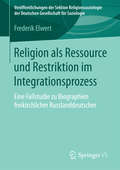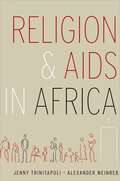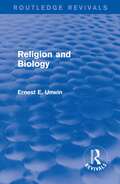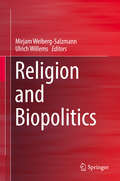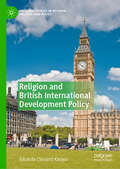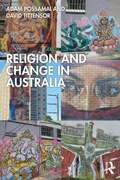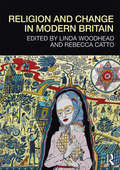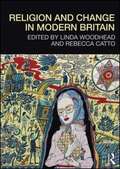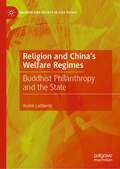- Table View
- List View
Religion Against the Self: An Ethnography of Tamil Rituals
by Isabelle NabokovThis book provides a holistic description of Hinduism, showing how different types of Hinduism form a "total" or systematic cosmology and repeat crucial values through different symbols. Looking at Tamil religious practices, Isabelle Nabokov reveals that Tamil religion is primarily concerned with transformations of identity and subjectivity, both in this world and in the hereafter.
Religion als Produkt der Evolution?: Vom Spiegelverhältnis zwischen Evolutionsanthropologie und Fundamentaltheologie (Religionswissenschaft #39)
by Hannah JudithDer Mensch ist ein evolutives Wesen - also ist der Mensch auch ein religiöses Wesen? Evolutionsanthropologische Theoriebildungen legen diesen Schluss nah. Sie führen in ein interdisziplinäres Spannungsfeld zwischen natürlicher Selektion, kognitiver Disposition und bewusster Sinnsuche. Auf sozialwissenschaftlicher und erkenntnisphilosophischer Grundlage reflektiert Hannah Judith die Herausforderungen, die daraus für die Theologie und Evolutionsanthropologie gleichermaßen erwachsen. Sie fragt nach der erkenntnistheoretischen Verortung religiöser Vollzüge im Evolutionsprozess - und stellt so die evolutionsanthropologische Relativierung religiöser Sinnsuche als theologieproduktiven Faktor heraus.
Religion als Ressource und Restriktion im Integrationsprozess: Eine Fallstudie zu Biographien freikirchlicher Russlanddeutscher (Veröffentlichungen der Sektion Religionssoziologie der Deutschen Gesellschaft für Soziologie)
by Frederik ElwertFrederik Elwert thematisiert den Zusammenhang von Migration, Religion und Integration am Beispiel einer wenig beachteten Fallgruppe: russlanddeutschen Aussiedlern in freikirchlichen Gemeinden. Als deutsche Staatsangehörige und evangelische Christen entsprechen sie nicht den gängigen Kategorien der Migrationsforschung und erlauben gerade daher neue Einblicke in die Bedeutung von Religion für Integrationsprozesse. Der Autor diskutiert dabei sowohl die theoretischen Konzepte der Integrationsforschung als auch empirische Befunde eigener biografischer Forschung mit jungen evangelikalen Aussiedlern.
Religion and Aging: An Anthology of the Poppele Papers
by Derrell R. WatkinsFind solace and wise counsel in these classics of spiritual gerontology!In these days, when so many people live beyond the Biblical threescore and ten, the spiritual questing and questioning of the aged demands a meaningful response from clergy, family members, and nursing home staff. The essays and research studies reprinted in Religion and Aging: An Anthology of the Poppele Papers investigate the role of faith in older people's lives. Many of these classic studies have been updated with new information.These essays were originally published in the Quarterly Papers on Religion and Aging. This renowned journal was issued from 1984 to 1994 by the Poppele Center for Health and Welfare Studies at the Saint Paul School of Theology in Kansas City, Missouri. The issues of spiritual gerontology discussed in that journal are still powerfully relevant today. Because back issues of the journal are not widely available, the cream of its ten-year history is being reissued in permanent form.Religion and Aging offers unfailing wisdom and insight in a broad range of issues, including: training clergy to be more responsive to the needs of older people a historical perspective on the meaning of ”honoring thy father and mother” in first-century Judaism and Christianity the Psalms as a way to help nursing home residents deal with pain, loneliness, anger, and other difficult emotions original research into belief patterns of older Americans ways to give meaning to suffering suggested by the lives and works of Viktor Frankl, Martin Gray, and Rabbi Harold Kushner techniques of communicating with older people Religion and Aging is an invaluable resource to anyone who works with old people, whether in adult day-care programs, nursing homes, hospitals, or other senior citizens’groups. It will help chaplains, pastors, rabbis, and other clergy minister more effectively to the older members of their flock.
Religion and Aging: An Anthology of the Poppele Papers
by Derrell R. WatkinsFind solace and wise counsel in these classics of spiritual gerontology!In these days, when so many people live beyond the Biblical threescore and ten, the spiritual questing and questioning of the aged demands a meaningful response from clergy, family members, and nursing home staff. The essays and research studies reprinted in Religion and Aging: An Anthology of the Poppele Papers investigate the role of faith in older people's lives. Many of these classic studies have been updated with new information.These essays were originally published in the Quarterly Papers on Religion and Aging. This renowned journal was issued from 1984 to 1994 by the Poppele Center for Health and Welfare Studies at the Saint Paul School of Theology in Kansas City, Missouri. The issues of spiritual gerontology discussed in that journal are still powerfully relevant today. Because back issues of the journal are not widely available, the cream of its ten-year history is being reissued in permanent form.Religion and Aging offers unfailing wisdom and insight in a broad range of issues, including: training clergy to be more responsive to the needs of older people a historical perspective on the meaning of ”honoring thy father and mother” in first-century Judaism and Christianity the Psalms as a way to help nursing home residents deal with pain, loneliness, anger, and other difficult emotions original research into belief patterns of older Americans ways to give meaning to suffering suggested by the lives and works of Viktor Frankl, Martin Gray, and Rabbi Harold Kushner techniques of communicating with older people Religion and Aging is an invaluable resource to anyone who works with old people, whether in adult day-care programs, nursing homes, hospitals, or other senior citizens’groups. It will help chaplains, pastors, rabbis, and other clergy minister more effectively to the older members of their flock.
Religion and AIDS in Africa
by Jenny Trinitapoli Alexander WeinrebThe first comprehensive empirical account of how religion affects the interpretation, prevention, and mitigation of AIDS in Africa, the world's most religious continent.
Religion and AIDS in Africa
by Jenny Trinitapoli Alexander WeinrebThe first comprehensive empirical account of how religion affects the interpretation, prevention, and mitigation of AIDS in Africa, the world's most religious continent.
Religion and AIDS Treatment in Africa: Saving Souls, Prolonging Lives
by Hansjörg Dilger Thera RasingThis book critically interrogates emerging interconnections between religion and biomedicine in Africa in the era of antiretroviral treatment for AIDS. Highlighting the complex relationships between religious ideologies, practices and organizations on the one hand, and biomedical treatment programmes and the scientific languages and public health institutions that sustain them on the other, this anthology charts largely uncovered terrain in the social science study of the Aids epidemic. Spanning different regions of Africa, the authors offer unique access to issues at the interface of religion and medical humanitarianism and the manifold therapeutic traditions, religious practices and moralities as they co-evolve in situations of AIDS treatment. This book also sheds new light on how religious spaces are formed in response to the dilemmas people face with the introduction of life-prolonging treatment programmes.
Religion and AIDS Treatment in Africa: Saving Souls, Prolonging Lives
by Hansjörg Dilger Thera RasingThis book critically interrogates emerging interconnections between religion and biomedicine in Africa in the era of antiretroviral treatment for AIDS. Highlighting the complex relationships between religious ideologies, practices and organizations on the one hand, and biomedical treatment programmes and the scientific languages and public health institutions that sustain them on the other, this anthology charts largely uncovered terrain in the social science study of the Aids epidemic. Spanning different regions of Africa, the authors offer unique access to issues at the interface of religion and medical humanitarianism and the manifold therapeutic traditions, religious practices and moralities as they co-evolve in situations of AIDS treatment. This book also sheds new light on how religious spaces are formed in response to the dilemmas people face with the introduction of life-prolonging treatment programmes.
Religion and American Literature Since 1950 (New Directions in Religion and Literature)
by Mark EatonFrom Flannery O'Connor and James Baldwin to the post-9/11 writings of Don DeLillo, imaginative writers have often been the most insightful chroniclers of the USA's changing religious life since the end of World War II. Exploring a wide range of writers from Protestant, Catholic, Jewish and secular faiths, this book is an in-depth study of contemporary fiction's engagement with religious belief, identity and practice. Through readings of major writers of our time like Saul Bellow, E. L. Doctorow, Philip Roth, Marilynne Robinson and John Updike, Mark Eaton discovers a more nuanced picture of the varieties of American religious experience: that they are more commonplace than cultural ideas of progressive secularisation or faith-based polarization might suggest.
Religion and American Literature Since 1950 (New Directions in Religion and Literature)
by Mark EatonFrom Flannery O'Connor and James Baldwin to the post-9/11 writings of Don DeLillo, imaginative writers have often been the most insightful chroniclers of the USA's changing religious life since the end of World War II. Exploring a wide range of writers from Protestant, Catholic, Jewish and secular faiths, this book is an in-depth study of contemporary fiction's engagement with religious belief, identity and practice. Through readings of major writers of our time like Saul Bellow, E. L. Doctorow, Philip Roth, Marilynne Robinson and John Updike, Mark Eaton discovers a more nuanced picture of the varieties of American religious experience: that they are more commonplace than cultural ideas of progressive secularisation or faith-based polarization might suggest.
Religion and Artificial Intelligence: An Introduction (Engaging with Religion)
by Beth SinglerArtificial intelligence (AI) is rarely out of the news or the public imagination. Images of red-eyed Terminators illustrate press accounts of incremental advances in medical diagnosis, facial recognition, natural language processing, and robotics. Such advances are transforming society through measurable impacts on people’s decisions and opportunities.Religion and Artificial Intelligence: An Introduction explores an emerging field with a religious studies approach, drawing on cultural and digital anthropological methods to demonstrate the entanglements of religion and AI, our imaginaries of these objects and our ideas about their utopian or dystopian futures. It addresses key topics, including the following: What AI is and is not. How religions are reacting to AI with examples of rejection, adoption, and adaptation. How established religions understand creation and place human-like AI within that. How overtly secular and even ‘new atheist’ groups understand AI as a tool for liberation from human evolution and religion. Religious visions of superintelligent AI. This engaging book is essential for anyone considering the relationship between religion, science and technology, and interested in the questions raised by transhumanism, posthumanism, and new religious movements.
Religion and Artificial Intelligence: An Introduction (Engaging with Religion)
by Beth SinglerArtificial intelligence (AI) is rarely out of the news or the public imagination. Images of red-eyed Terminators illustrate press accounts of incremental advances in medical diagnosis, facial recognition, natural language processing, and robotics. Such advances are transforming society through measurable impacts on people’s decisions and opportunities.Religion and Artificial Intelligence: An Introduction explores an emerging field with a religious studies approach, drawing on cultural and digital anthropological methods to demonstrate the entanglements of religion and AI, our imaginaries of these objects and our ideas about their utopian or dystopian futures. It addresses key topics, including the following: What AI is and is not. How religions are reacting to AI with examples of rejection, adoption, and adaptation. How established religions understand creation and place human-like AI within that. How overtly secular and even ‘new atheist’ groups understand AI as a tool for liberation from human evolution and religion. Religious visions of superintelligent AI. This engaging book is essential for anyone considering the relationship between religion, science and technology, and interested in the questions raised by transhumanism, posthumanism, and new religious movements.
Religion and Belief Literacy: Reconnecting a Chain of Learning
by Adam DinhamThis book presents a crisis of religion and belief literacy to which education at every level is challenged to respond. As understanding different religions, beliefs and influences becomes increasingly important, it fills a gap for a resource in bringing together the debates around religious literacy, from theoretical approaches to teaching and policy. This timely publication provides a clear pathway for engaging well with religion and belief diversity in public and shared settings.
Religion and Belief Literacy: Reconnecting a Chain of Learning
by Adam DinhamThis book presents a crisis of religion and belief literacy to which education at every level is challenged to respond. As understanding different religions, beliefs and influences becomes increasingly important, it fills a gap for a resource in bringing together the debates around religious literacy, from theoretical approaches to teaching and policy. This timely publication provides a clear pathway for engaging well with religion and belief diversity in public and shared settings.
Religion and Biology
by Ernest E. UnwinFirst published in 1922, this book represents an attempt to outline the biological approach to the questions of religious thought. The author posits the book as a contribution to religious thought in relation to the purpose of God in Nature, providing readers with an overview of the advances and changes in thought that had occurred in the years before the book was written. The examinations of the nature of man and of evolution in relation to religion make up the bulk of the book along with a look at the argument from beauty. The book will be of interest to students of religion, biology and philosophy.
Religion and Biology
by Ernest E. UnwinFirst published in 1922, this book represents an attempt to outline the biological approach to the questions of religious thought. The author posits the book as a contribution to religious thought in relation to the purpose of God in Nature, providing readers with an overview of the advances and changes in thought that had occurred in the years before the book was written. The examinations of the nature of man and of evolution in relation to religion make up the bulk of the book along with a look at the argument from beauty. The book will be of interest to students of religion, biology and philosophy.
Religion and Biopolitics
by Ulrich Willems Mirjam Weiberg-SalzmannGiven the profound moral-ethical controversies regarding the use of new biotechnologies in medical research and treatment, such as embryonic research and cloning, this book sheds new light on the role of religious organizations and actors in influencing the bio-political debates and decision-making processes. Further, it analyzes the ways in which religious traditions and actors formulate their bio-ethical positions and which rationales they use to validate their positions. The book offers a range of case studies on fourteen Western democracies, highlighting the bio-ethical and political debates over human stem cell research, therapeutic and reproductive cloning, and pre-implantation genetic diagnosis. The contributing authors illustrate the ways in which national political landscapes and actors from diverse and often fragmented moral communities with widely varying moral stances, premises and commitments formulate their bio-ethical positions and seek to influence political decisions.
Religion and British International Development Policy (Palgrave Studies in Religion, Politics, and Policy)
by Aikande Clement KwayuThis book studies the relationship between British government and faith groups in its international development agenda within and beyond the context of Brexit. It includes aspects of International Relations, International Development, and Religion and Politics to trace the relationship between the British government and faith groups, showing that the relationship is enhanced on three conditions: (i) the resurgence of religion in international affairs; (ii) the attitudes of politicians and political parties towards the third sector (i.e. voluntary and private sectors); and (iii) the rising prominence of the international development agenda in British politics. The third condition triggers the need to understand this relationship in the wake of Brexit. Thus, the book aims to analyze to what extent the increasing prominence of an international development agenda in British politics explains the relationship between the government and faith groups, and ultimately whether Brexit has increased the prominence of international development agenda and brought faith groups into closer relations with the government.
Religion and Change in Australia
by Adam Possamai David TittensorThis timely book offers a panoramic overview of the enduring significance of religion in modern Australian society. Applying sociological perspectives and contemporary theories of religion in society, it challenges conventional assumptions around the extent of secularisation in Australia and instead argues that religious institutions, groups, and individuals have proved remarkably adaptable to social change and continue to play a major role in Australian life. In doing so, it explores how religion intersects with a wide range of other contemporary issues, including politics, race, migration, gender, and new media. Religion and Change in Australia explores Australia’s unique history regarding religion. Christianity was originally imported as a tool of social control to keep convicts, settlers, and Australian Aboriginal peoples in check. This had a profound impact on the social memory of the nation, and lingering resentment towards the "excessive" presence of religion continues to be felt today. Freedom of religion was enshrined in Section 116 of the Australian Constitution in 1901. Nevertheless, the White Australia Policy effectively prevented adherents of non-Christian faiths from migrating to Australia and the nation remained overwhelmingly Christian. However, after WWII, Australia, in common with other western societies, appears to have become increasingly secularised, as religious observance declined dramatically. However, Religion and Change in Australia employs a range of social theories to challenge this securalist view and argues that Australia is a post-secular society. The 2016 census revealed that over half of the population still identify as Christian. In politics, the socially conservative religious right has come to exert considerable influence on the ruling Liberal-National Coalition, particularly under John Howard and Scott Morrison. New technologies, such as the Internet and social media, have provided new avenues for religious expression and proselytisation whilst so-called "megachurches" have been built to cater to their increasing congregations. The adoption of multiculturalism and increased immigration from Asia has led to a religiously pluralist society, though this has often been controversial. In particular, the position of Islam in Australia has been the subject of fierce debate, and Islamophobic attitudes remain common. Atheism, non-belief, and alternative spiritualities have also become increasingly widespread, especially amongst the young. Religion and Change in Australia analyses these developments to offer new perspectives on religion and its continued relevance within Australian society. This book is therefore a vital resource for students, academics, and general readers seeking to understand contemporary debates surrounding religion and secularisation in Australia.
Religion and Change in Australia
by Adam Possamai David TittensorThis timely book offers a panoramic overview of the enduring significance of religion in modern Australian society. Applying sociological perspectives and contemporary theories of religion in society, it challenges conventional assumptions around the extent of secularisation in Australia and instead argues that religious institutions, groups, and individuals have proved remarkably adaptable to social change and continue to play a major role in Australian life. In doing so, it explores how religion intersects with a wide range of other contemporary issues, including politics, race, migration, gender, and new media. Religion and Change in Australia explores Australia’s unique history regarding religion. Christianity was originally imported as a tool of social control to keep convicts, settlers, and Australian Aboriginal peoples in check. This had a profound impact on the social memory of the nation, and lingering resentment towards the "excessive" presence of religion continues to be felt today. Freedom of religion was enshrined in Section 116 of the Australian Constitution in 1901. Nevertheless, the White Australia Policy effectively prevented adherents of non-Christian faiths from migrating to Australia and the nation remained overwhelmingly Christian. However, after WWII, Australia, in common with other western societies, appears to have become increasingly secularised, as religious observance declined dramatically. However, Religion and Change in Australia employs a range of social theories to challenge this securalist view and argues that Australia is a post-secular society. The 2016 census revealed that over half of the population still identify as Christian. In politics, the socially conservative religious right has come to exert considerable influence on the ruling Liberal-National Coalition, particularly under John Howard and Scott Morrison. New technologies, such as the Internet and social media, have provided new avenues for religious expression and proselytisation whilst so-called "megachurches" have been built to cater to their increasing congregations. The adoption of multiculturalism and increased immigration from Asia has led to a religiously pluralist society, though this has often been controversial. In particular, the position of Islam in Australia has been the subject of fierce debate, and Islamophobic attitudes remain common. Atheism, non-belief, and alternative spiritualities have also become increasingly widespread, especially amongst the young. Religion and Change in Australia analyses these developments to offer new perspectives on religion and its continued relevance within Australian society. This book is therefore a vital resource for students, academics, and general readers seeking to understand contemporary debates surrounding religion and secularisation in Australia.
Religion and Change in Modern Britain
by Linda Woodhead Rebecca CattoThis book offers a fully up-to-date and comprehensive guide to religion in Britain since 1945. A team of leading scholars provide a fresh analysis and overview, with a particular focus on diversity and change. They examine: relations between religious and secular beliefs and institutions the evolving role and status of the churches the growth and ‘settlement’ of non-Christian religious communities the spread and diversification of alternative spiritualities religion in welfare, education, media, politics and law theoretical perspectives on religious change. The volume presents the latest research, including results from the largest-ever research initiative on religion in Britain, the AHRC/ESRC Religion and Society Programme. Survey chapters are combined with detailed case studies to give both breadth and depth of coverage. The text is accompanied by relevant photographs and a companion website.
Religion and Change in Modern Britain
by Linda Woodhead Rebecca CattoThis book offers a fully up-to-date and comprehensive guide to religion in Britain since 1945. A team of leading scholars provide a fresh analysis and overview, with a particular focus on diversity and change. They examine: relations between religious and secular beliefs and institutions the evolving role and status of the churches the growth and ‘settlement’ of non-Christian religious communities the spread and diversification of alternative spiritualities religion in welfare, education, media, politics and law theoretical perspectives on religious change. The volume presents the latest research, including results from the largest-ever research initiative on religion in Britain, the AHRC/ESRC Religion and Society Programme. Survey chapters are combined with detailed case studies to give both breadth and depth of coverage. The text is accompanied by relevant photographs and a companion website.
Religion and Change in Modern Britain (PDF)
by Linda Woodhead Rebecca CattoThis book offers a fully up-to-date and comprehensive guide to religion in Britain since 1945. A team of leading scholars provide a fresh analysis and overview, with a particular focus on diversity and change. They examine: relations between religious and secular beliefs and institutions the evolving role and status of the churches the growth and 'settlement' of non-Christian religious communities the spread and diversification of alternative spiritualities religion in welfare, education, media, politics and law theoretical perspectives on religious change.
Religion and China's Welfare Regimes: Buddhist Philanthropy and the State (Religion and Society in Asia Pacific)
by André LalibertéThis book presents the welfare regime of China as a liminal space where religious and state authorities struggle for legitimacy as new social forces emerge. It offers a unique analysis of relations between religion and state in the People’s Republic of China by presenting how the Chinese Communist Party (CCP) tries to harness Buddhist resources to assist in the delivery of social services and sheds light on the intermingling of Buddhism and the state since 1949. This book will appeal to academics in social sciences and humanities and broader audiences interested in the social role of religions, charity, NGOs, and in social policy implementation. The author explores why the CCP turns to Buddhist followers and their leaders and presents a detailed view of Buddhist philanthropy, contextualized with an historical overview, a regional comparative perspective, and a review of policy debates. This book contributes to our understanding of secularity in a major non-Western society influenced by religions other than Christianity.


